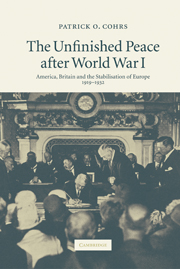Book contents
- Frontmatter
- Contents
- Acknowledgements
- List of abbreviations
- A note on the footnotes and bibliography
- Introduction
- Prologue
- 1 The wider challenges
- 2 Wilson, Lloyd George and the quest for a ‘peace to end all wars’
- 3 The ill-founded peace of 1919
- 4 The escalation of Europe's post-Versailles crisis, 1920–1923
- Part I The Anglo-American stabilisation of Europe, 1923–1924
- Part II Europe's nascent Pax Anglo-Americana, 1924–1925
- Part III The unfinished transatlantic peace order: the system of London and Locarno, 1926–1929
- 17 Sustaining stability, legitimating peaceful change
- 18 Progressive visions and limited commitments
- 19 ‘Reciprocity’?
- 20 The new European concert – and its limits
- 21 Thoiry – the failed quest for a ‘final postwar agreement’
- 22 Towards peaceful change in eastern Europe?
- 23 Achievements and constraints
- 24 No ‘new world order’
- 25 The initiation of the Young process
- 26 The last ‘grand bargain’ after World War I
- Epilogue
- Conclusion
- Map: Post-World War I Europe after the peace settlement of Versailles
- Bibliography
- Index
17 - Sustaining stability, legitimating peaceful change
The challenges of the latter 1920s
Published online by Cambridge University Press: 21 July 2009
- Frontmatter
- Contents
- Acknowledgements
- List of abbreviations
- A note on the footnotes and bibliography
- Introduction
- Prologue
- 1 The wider challenges
- 2 Wilson, Lloyd George and the quest for a ‘peace to end all wars’
- 3 The ill-founded peace of 1919
- 4 The escalation of Europe's post-Versailles crisis, 1920–1923
- Part I The Anglo-American stabilisation of Europe, 1923–1924
- Part II Europe's nascent Pax Anglo-Americana, 1924–1925
- Part III The unfinished transatlantic peace order: the system of London and Locarno, 1926–1929
- 17 Sustaining stability, legitimating peaceful change
- 18 Progressive visions and limited commitments
- 19 ‘Reciprocity’?
- 20 The new European concert – and its limits
- 21 Thoiry – the failed quest for a ‘final postwar agreement’
- 22 Towards peaceful change in eastern Europe?
- 23 Achievements and constraints
- 24 No ‘new world order’
- 25 The initiation of the Young process
- 26 The last ‘grand bargain’ after World War I
- Epilogue
- Conclusion
- Map: Post-World War I Europe after the peace settlement of Versailles
- Bibliography
- Index
Summary
Undoubtedly, as both Chamberlain and Kellogg perceived distinctly in the aftermath of the security pact negotiations, Briand and Stresemann harboured different, partly conflicting ideas about what kind of new order was to emerge in ‘the spirit of Locarno’. In particular, they disagreed on how rapidly any further changes of the European status quo ought to proceed, how substantial they were to be and according to what understandings of quid pro quo they were to be brought about. Their ‘visions’ were not least influenced by the struggle that each of them faced in legitimating the accords in their respective countries.
Stresemann saw Germany's ‘security initiative' and signature under the Locarno pact as a substantial German advance to meet the postwar security concerns of the ex-allied powers and especially those of France. He expected them to be rewarded by stepped-up peaceful change or what he called Rückwirkungen (‘consequences’). Most urgently, the German foreign minister sought a swift and complete French withdrawal from the Rhineland. Likewise, he hoped for a greater understanding of the western powers for German demands to end military control. Eventually, even if this became an ever more distant objective, he also sought to create conditions that might permit a peaceful, in his outlook economically ‘rational’ revision of Germany's eastern borders. In his calculation, however, such changes could only be achieved with the consent of the western powers, including France; and they could only materialise if Warsaw could be ‘convinced’, politically and through economic pressure, that such an arrangement was also in Poland's best interest.
- Type
- Chapter
- Information
- The Unfinished Peace after World War IAmerica, Britain and the Stabilisation of Europe, 1919–1932, pp. 287 - 295Publisher: Cambridge University PressPrint publication year: 2006



